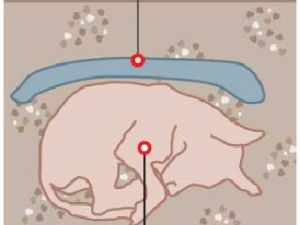 |
Canku Ota
|
 |
|
(Many Paths)
|
||
|
An Online Newsletter
Celebrating Native America
|
||
|
August 1, 2010 - Volume
8 Number 7
|
||
|
|
||
|
Prehistoric Pet?
Dog Burial Found In O.C. |
||
|
byPat Brennan - The
Orange County (CA) Register
|
||
|
But 18 centuries ago, someone carefully positioned the body of a small dog in what was likely a shallow grave in the marshlands of Laguna Canyon, then turned over a stone grinding bowl to cover the animal. Four years ago, the dog's burial place was discovered by archaeologists keeping watch for artifacts during the widening of Laguna Canyon Road. On Thursday night, scientists will give a talk on the discovery of the dog burial, among fewer than 10 ever found in Orange County. The talk, hosted by the Pacific Coast Archaeological Society, is free and open to the public. The dog was a techichi, or "small Indian dog," of a type that was about the size of a terrier and that is now extinct. But the scientists involved in the discovery know little else, including why it was buried at all. "It might have been just a pet burial," said Paul E. Langenwalter II, a research archaeologist who teaches archaeology at Biola University. "But it could be destruction of property. It was common to kill the dog along with burning or destroying any other personal property upon the death of the owner." The dog would have had erect ears and tail and stood about 15 inches high at the shoulder. A radiocarbon date places it at about 1,790 years ago, Langenwalter said. Ancient pet burials are uncommon, he said; fewer than 10 have been found in Orange County, an area rich in Native American artifacts, and only a few dozen are known statewide. Even more intriguing are the positioning of the dog and the placement of a "cairn" — a rock marker, in this case a large acorn grinding-bowl or metate — on top of it. "The cairn is rare, and the burial position — having been folded sideways — is entirely new to archaeological knowledge within California,"Langenwalter said. While dog burials are usually associated with Native American villages, the area where the dog was found likely served only as a frequently used campsite. Langenwalter, archaeologist Roderick McLean of LSA Associates, Inc., and Joyce Perry, an Acjachemen scholar and manager for the Juaneño Band of Mission Indians, will give a talk on the find at the Irvine Ranch Water District, 15600 Sand Canyon Ave., Irvine, beginning at 7 p.m. Thursday. |
|
|
||
|
|
||
| Canku Ota is a free Newsletter celebrating Native America, its traditions and accomplishments . We do not provide subscriber or visitor names to anyone. Some articles presented in Canku Ota may contain copyright material. We have received appropriate permissions for republishing any articles. Material appearing here is distributed without profit or monetary gain to those who have expressed an interest. This is in accordance with Title 17 U.S.C. Section 107. | ||
|
Canku Ota is a copyright ©
2000, 2001, 2002, 2003, 2004, 2005, 2006, 2007, 2008, 2009, 2010
of Vicki Barry and Paul Barry.
|
||
 |
 |
|
|
The "Canku
Ota - A Newsletter Celebrating Native America" web site and
its design is the
|
||
|
Copyright ©
1999, 2000, 2001, 2002, 2003, 2004, 2005,
2006, 2007, 2008, 2009, 2010
of Paul C. Barry.
|
||
|
All Rights Reserved.
|
||
 It
might have been a treasured pet, or the victim of traditional destruction
of property after its owner's death. The reason for its burial remains
a mystery.
It
might have been a treasured pet, or the victim of traditional destruction
of property after its owner's death. The reason for its burial remains
a mystery.